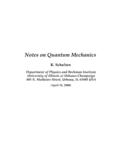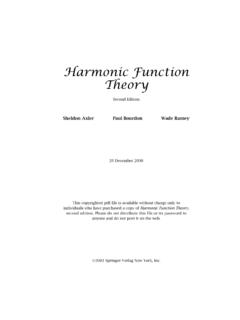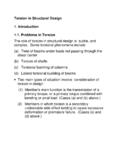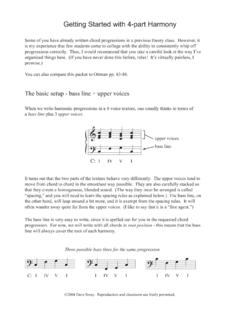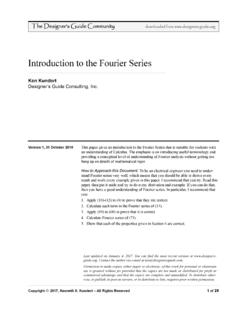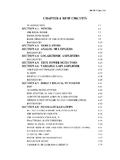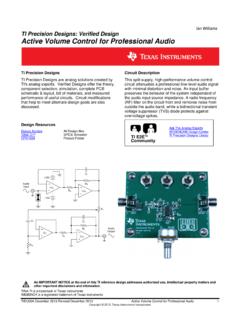Transcription of Notes on Quantum Mechanics
1 Notes on Quantum MechanicsK. SchultenDepartment of Physics and Beckman InstituteUniversity of Illinois at Urbana Champaign405 N. Mathews Street, Urbana, IL 61801 USA(April 18, 2000)PrefaceiPrefaceThe following Notes introduceQuantum Mechanicsat an advanced level addressing students of Physics,Mathematics, Chemistry and Electrical Engineering. The aim is to put mathematical concepts and tech-niques like the path integral, algebraic techniques, Lie algebras and representation theory at the readersdisposal. For this purpose we attempt to motivate the various physical and mathematical concepts as wellas provide detailed derivations and complete sample calculations. We have made every effort to include inthe derivations all assumptions and all mathematical steps implied, avoiding omission of supposedly trivial information. Much of the author s writing effort went into a web of cross references accompanying the mathe-matical derivations such that the intelligent and diligent reader should be able to follow the text with relativeease, in particular, also when mathematically difficult material is presented.
2 In fact, the author s drivingforce has been his desire to pave the reader s way into territories unchartered previously in most introduc-tory textbooks, since few practitioners feel obliged to ease access to their field. Also the author embracedenthusiastically the potential of the TEX typesetting language to enhance the presentation of equations asto make the logical pattern behind the mathematics as transparent as possible. Any suggestion to improvethe text in the respects mentioned are most welcome. It is obvious, that even though these Notes attemptto serve the reader as much as was possible for the author, the main effort to follow the text and to masterthe material is left to the Notes start out in Section 1 with a brief review ofClassical Mechanicsin the Lagrange formulation andbuild on this to introduce in Section 2 Quantum Mechanicsin the closely relatedpath integral formulation. InSection 3 theSchr odinger equationis derived and used as an alternative description of continuous quantumsystems.
3 Section 4 is devoted to adetailed presentation of the harmonic oscillator, introducing algebraictechniques and comparing their use with more conventional mathematical procedures. In Section 5 weintroduce thepresentation theory of the 3-dimensional rotation group and the group SU(2)presenting Liealgebra and Lie group techniques and applying the methods to the theory of angular momentum, of the spinof single particles and of angular momenta and spins of composite systems. In Section 6 we present thetheoryof many boson and many fermion systemsin a formulation exploiting the algebra of the associated creationand annihilation operators. Section 7 provides an introduction toRelativistic Quantum Mechanicswhichbuilds on the representation theory of the Lorentz group and its complex relativeSl(2,C). This section makesa strong effort to introduce Lorentz invariant field equations systematically, rather than relying mainly ona heuristic amalgam of Classical Special Relativity and Quantum Notes are in a stage of continuing development, various sections, , on the semiclassical approximation,on the Hilbert space structure of Quantum Mechanics , on scattering theory, on perturbation theory, onStochastic Quantum Mechanics , and on the group theory of elementary particles will be added as well asthe existing sections expanded.
4 However, at the present stage the Notes , for the topics covered, should becomplete enough to serve the author would like to thank Markus van Almsick and Heichi Chan for help with these Notes . Theauthor is also indebted to his department and to his University; their motivated students and their inspiringatmosphere made teaching a worthwhile effort and a great Notes were produced entirely on a Macintosh II computer using the TEX typesetting system, Textures,Mathematica and Adobe SchultenUniversity of Illinois at Urbana ChampaignAugust 1991iiPrefaceContents1 Lagrangian Basics of Variational Calculus .. Lagrangian Mechanics .. Symmetry Properties in Lagrangian Mechanics ..72 Quantum Mechanical Path The Double Slit Experiment .. Axioms for Quantum Mechanical Description of Single Particle .. How to Evaluate the Path Integral .. Propagator for a Free Particle.
5 Propagator for a Quadratic Lagrangian .. Wave Packet Moving in Homogeneous Force Field .. Stationary States of the Harmonic Oscillator .. 343 The Schr odinger Derivation of the Schr odinger Equation .. Boundary Conditions .. Particle Flux and Schr odinger Equation .. Solution of the Free Particle Schr odinger Equation .. Particle in One-Dimensional Box .. Particle in Three-Dimensional Box .. 694 Linear Harmonic Creation and Annihilation Operators .. Ground State of the Harmonic Oscillator .. Excited States of the Harmonic Oscillator .. Propagator for the Harmonic Oscillator .. Working with Ladder Operators .. Momentum Representation for the Harmonic Oscillator .. Quasi-Classical States of the Harmonic Oscillator .. 905 Theory of Angular Momentum and Matrix Representation of the group SO(3).
6 Function space representation of the group SO(3) .. Angular Momentum Operators .. Angular Momentum Eigenstates .. Irreducible Representations .. Wigner Rotation Matrices .. Spin12and the group SU(2) .. Generators and Rotation Matrices of SU(2) .. Constructing Spin States with Larger Quantum Numbers Through Spinor Operators Algebraic Properties of Spinor Operators .. Evaluation of the Elementsdjmm ( ) of the Wigner Rotation Matrix .. Mapping of SU(2) onto SO(3) .. 1396 Quantum Mechanical Addition of Angular Momenta and Clebsch-Gordan Coefficients .. Construction of Clebsch-Gordan Coefficients .. Explicit Expression for the Clebsch Gordan Coefficients .. Symmetries of the Clebsch-Gordan Coefficients .. : Spin Orbital Angular Momentum States .. The 3j Coefficients .. Tensor Operators and Wigner-Eckart Theorem.
7 Wigner-Eckart Theorem .. 1797 Motion in Spherically Symmetric Radial Schr odinger Equation .. Free Particle Described in Spherical Coordinates .. 1888 Interaction of Charged Particles with Electromagnetic Description of the Classical Electromagnetic Field / Separation of Longitudinal andTransverse Components .. Planar Electromagnetic Waves .. Hamilton Operator .. Electron in a Stationary Homogeneous Magnetic Field .. Time-Dependent Perturbation Theory .. Perturbations due to Electromagnetic Radiation .. One-Photon Absorption and Emission in Atoms .. Two-Photon Processes .. 2309 Many Particle Permutation Symmetry of Bosons and Fermions .. Operators of 2nd Quantization .. One and Two Particle Operators .. Independent-Particle Models .. Self-Consistent Field Theory .. Self-Consistent Field Algorithm.
8 Properties of the SCF Ground State .. Mean Field Theory for Macroscopic Systems .. 272 Contentsv10 Relativistic Quantum Natural Representation of the Lorentz Group .. Scalars, 4 Vectors and Tensors .. Relativistic Electrodynamics .. Function Space Representation of Lorentz Group .. Klein Gordon Equation .. Klein Gordon Equation for Particles in an Electromagnetic Field .. The Dirac Equation .. Lorentz Invariance of the Dirac Equation .. Solutions of the Free Particle Dirac Equation .. Particles in Electromagnetic Field .. 33311 Spinor Formulation of Relativistic Quantum The Lorentz Transformation of the Dirac Bispinor .. Relationship Between the Lie Groups SL(2,C) and SO(3,1) .. Spinors .. Spinor Tensors .. Lorentz Invariant Field Equations in Spinor Form .. 36912 Symmetries in Physics: Isospin and the Eightfold Symmetry and Degeneracies.
9 Isospin and theSU(2) flavor symmetry .. The Eightfold Way and the flavorSU(3) symmetry .. 380viContentsChapter 1 Lagrangian MechanicsOur introduction to Quantum Mechanics will be based on its correspondence to Classical this purpose we will review the relevant concepts of Classical Mechanics . An important conceptis that the equations of motion of Classical Mechanics can be based on a variational principle,namely, that along a path describing classical motion the action integral assumes a minimal value(Hamiltonian Principle of Least Action). Basics of Variational CalculusThe derivation of the Principle of Least Action requires the tools of the calculus of variation whichwe will provide : AfunctionalS[ ] is a mapS[ ] :F R;F={~q(t);~q: [t0,t1] R RM;~q(t) differentiable}( )from a spaceFof vector-valued functions~q(t) onto the real numbers.~q(t) is called thetrajec-toryof a system ofMdegrees of freedom described by theconfigurational coordinates~q(t) =(q1(t),q2(t).)
10 QM(t)).In case ofNclassical particles holdsM= 3N, , there are 3 Nconfigurational coordinates,namely, the position coordinates of the particles in any kind of coordianate system, often in theCartesian coordinate system. It is important to note at the outset that for the description of aclassical system it will be necessary to provide information~q(t) as well asddt~q(t). The latter is thevelocity vector of the : A functionalS[ ] isdifferentiable, if for any~q(t) Fand ~q(t) F whereF ={ ~q(t); ~q(t) F,| ~q(t)|< ,|ddt ~q(t)|< , t, t [t0,t1] R}( )a functional S[ , ] exists with the properties(i)S[~q(t) + ~q(t)] =S[~q(t)] + S[~q(t), ~q(t)] +O( 2)(ii) S[~q(t), ~q(t)] is linear in ~q(t).( ) S[ , ] is called thedifferentialofS[ ]. The linearity property above implies S[~q(t), 1 ~q1(t) + 2 ~q2(t)] = 1 S[~q(t), ~q1(t)] + 2 S[~q(t), ~q2(t)].( )12 Lagrangian MechanicsNote: ~q(t) describes small variations around the trajectory~q(t), ~q(t) + ~q(t) is a slightly different trajectory than~q(t).

